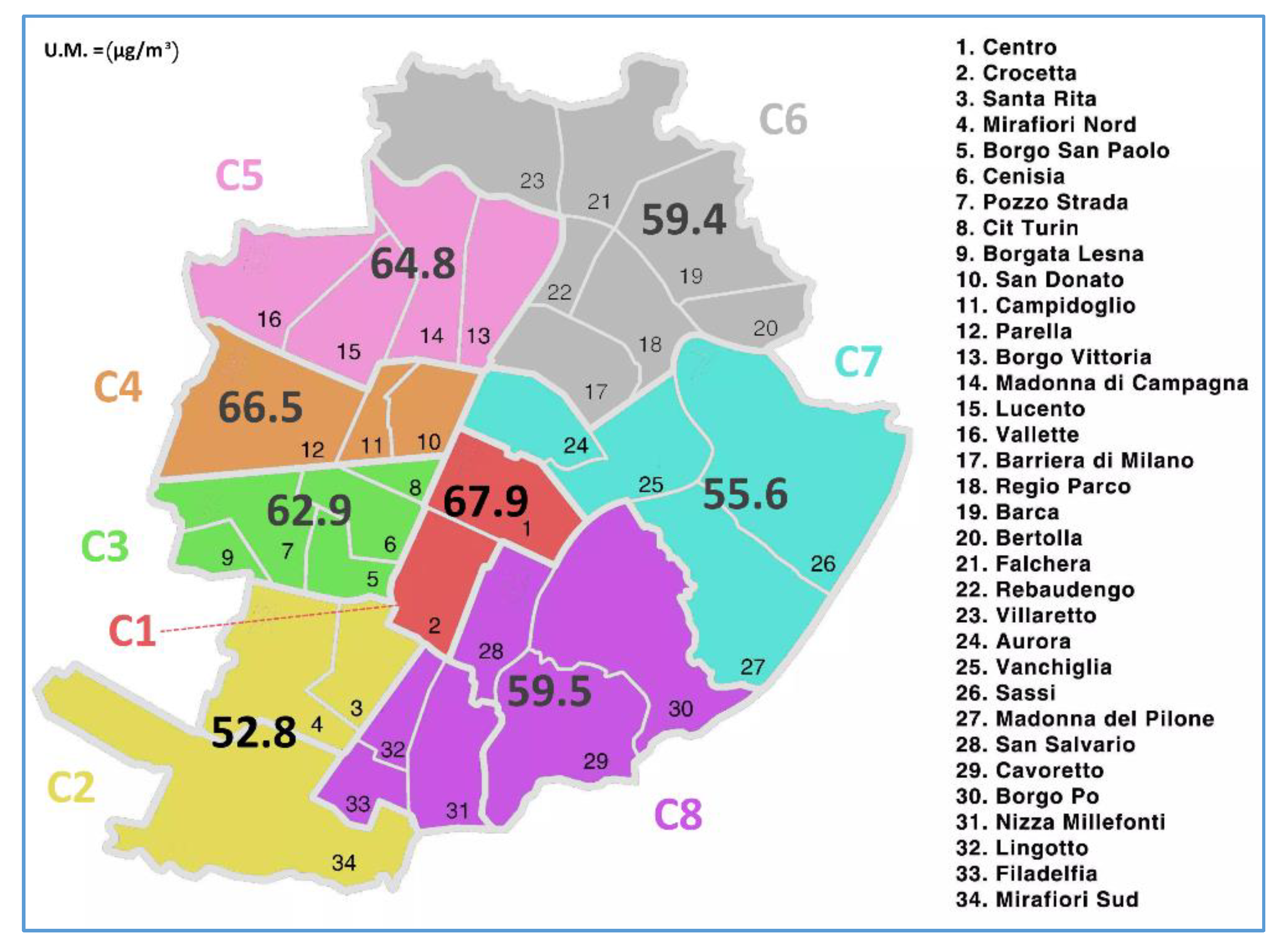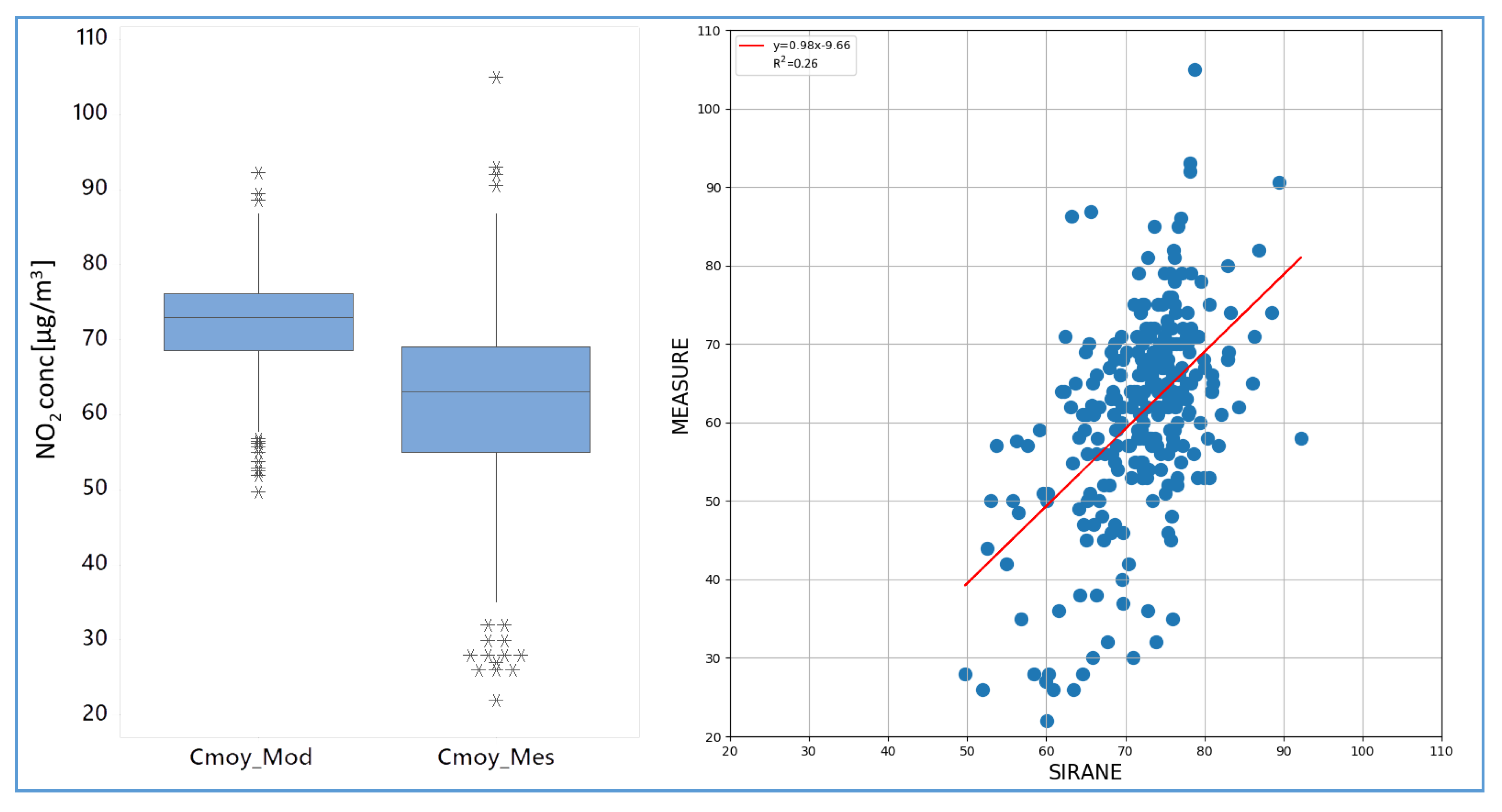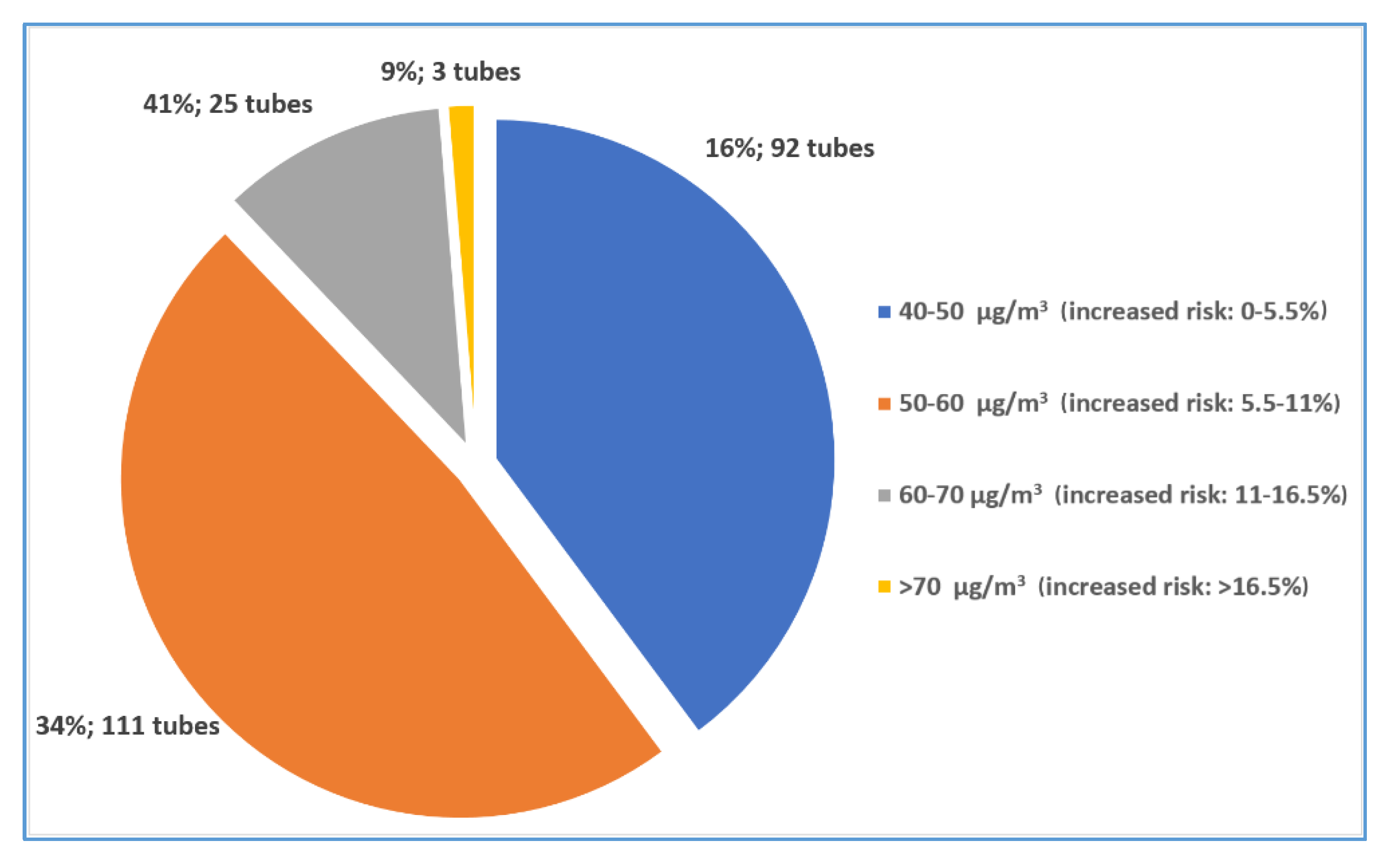A Combined Citizen Science—Modelling Approach for NO2 Assessment in Torino Urban Agglomeration
Abstract
:1. Introduction
2. Materials and Methods
2.1. #CHEARIATIRA Campaign
2.2. SIRANE Modelling
3. Validation
3.1. #CHEARIATIRA Campaign
3.2. SIRANE Modelling
4. Exposure Assessment
5. Discussion
6. Conclusions
Author Contributions
Funding
Acknowledgments
Conflicts of Interest
References
- Lelieveld, J.; Evans, J.S.; Fnais, M.; Giannadaki, D.; Pozzer, A. The contribution of outdoor air pollution sources to premature mortality on a global scale. Nature 2015, 525, 367–371. [Google Scholar] [CrossRef] [PubMed]
- WHO. WHO|Global Health Risks Report. Available online: http://www.who.int/healthinfo/global_burden_disease/global_health_risks/en/ (accessed on 22 May 2017).
- WHO. WHO|Ambient Air Pollution: A Global Assessment of Exposure and Burden of Disease. Available online: http://www.who.int/phe/publications/air-pollution-global-assessment/en/ (accessed on 11 May 2017).
- European Environmental Agency. EEA Air Quality in Europe—2015 Report; European Environmental Agency: Copenhagen, Denmark, 2015. [Google Scholar]
- Van Donkelaar, A.; Martin, R.V.; Brauer, M.; Kahn, R.; Levy, R.C.; Verduzco, C.; Villeneuve, P.J. Global Estimates of Ambient Fine Particulate Matter Concentrations from Satellite-Based Aerosol Optical Depth: Development and Application. Environ. Health Perspect. 2010, 118, 847–855. [Google Scholar] [CrossRef] [Green Version]
- ESA Copernicus Sentinel-5P: Maps of Nitrogen Dioxide Pollution. Available online: https://www.esa.int/Our_Activities/Observing_the_Earth/Copernicus/Sentinel-5P/Nitrogen_dioxide_pollution_mapped (accessed on 31 May 2019).
- Rossi, G.; Vigotti, M.A.; Zanobetti, A.; Repetto, F.; Gianelle, V.; Schwartz, J. Air Pollution and Cause-Specific Mortality in Milan, Italy, 1980–1989. Arch. Environ. Health Int. J. 1999, 54, 158–164. [Google Scholar] [CrossRef] [PubMed]
- Giulianelli, L.; Gilardoni, S.; Tarozzi, L.; Rinaldi, M.; Decesari, S.; Carbone, C.; Facchini, M.C.; Fuzzi, S. Fog occurrence and chemical composition in the Po valley over the last twenty years. Atmos. Environ. 2014, 98, 394–401. [Google Scholar] [CrossRef]
- Baklanov, A.; Kukkonen, J.; Finardi, S.; Beekmann, M.; Sokhi, R.; Mahura, A.; Ginsburg, A.; Mažeikis, A. Meteorological Conditions Favouring Development of Urban Air Pollution Episodes. Megapoli Sci. Rep. 10-10 2013, 15, EGU2013-12835. [Google Scholar]
- Bigi, A.; Ghermandi, G. Trends and variability of atmospheric PM2.5 and PM10–2.5 concentration in the Po Valley, Italy. Atmos. Chem. Phys. Discuss. 2016, 16, 15777–15788. [Google Scholar] [CrossRef] [Green Version]
- Diémoz, H.; Gobbi, G.P.; Magri, T.; Pession, G.; Pittavino, S.; Tombolato, I.K.F.; Campanelli, M.; Barnaba, F. Transport of Po Valley aerosol pollution to the northwestern Alps—Part 2: Long-term impact on air quality. Atmos. Chem. Phys. Discuss. 2019, 19, 10129–10160. [Google Scholar] [CrossRef] [Green Version]
- Bo, M.; Mercalli, L.; Pognant, F.; Berro, D.C.; Clerico, M.; Luca, M.; Federica, P.; Daniele, C.B.; Marina, C.; Matteo, B. Urban air pollution, climate change and wildfires: The case study of an extended forest fire episode in northern Italy favoured by drought and warm weather conditions. Energy Rep. 2020, 6, 781–786. [Google Scholar] [CrossRef]
- Westerling, A.L.; Bryant, B.P. Climate change and wildfire in California. Clim. Chang. 2007, 87, 231–249. [Google Scholar] [CrossRef]
- Jacob, D.J.; Winner, D.A. Effect of climate change on air quality. Atmos. Environ. 2009, 43, 51–63. [Google Scholar] [CrossRef] [Green Version]
- Wiggins, A.; Wilbanks, J. The Rise of Citizen Science in Health and Biomedical Research. Am. J. Bioeth. 2019, 19, 3–14. [Google Scholar] [CrossRef] [Green Version]
- Mahajan, S.; Kumar, P.; Pinto, J.A.; Riccetti, A.; Schaaf, K.; Camprodon, G.; Smári, V.; Passani, A.; Forino, G.; Riccetti, A. A citizen science approach for enhancing public understanding of air pollution. Sustain. Cities Soc. 2020, 52, 101800. [Google Scholar] [CrossRef]
- English, P.; Olmedo, L.; Bejarano, E.; Lugo, H.; Murillo, E.; Seto, E.; Wong, M.; King, G.; Wilkie, A.; Meltzer, D.; et al. The Imperial County Community Air Monitoring Network: A Model for Community-based Environmental Monitoring for Public Health Action. Environ. Health Perspect. 2017, 125, 074501. [Google Scholar] [CrossRef] [PubMed] [Green Version]
- Ford, B.; Pierce, J.R.; Wendt, E.; Long, M.; Jathar, S.H.; Mehaffy, J.; Tryner, J.; Quinn, C.W.; Van Zyl, L.; L’Orange, C.; et al. A low-cost monitor for measurement of fine particulate matter and aerosol optical depth – Part 2: Citizen-science pilot campaign in northern Colorado. Atmos. Meas. Tech. 2019, 12, 6385–6399. [Google Scholar] [CrossRef] [Green Version]
- Benabbas, A.; Geißelbrecht, M.; Nikol, G.M.; Mahr, L.; Nähr, D.; Steuer, S.; Wiesemann, G.; Müller, T.; Nicklas, D.; Wieland, T. Measure particulate matter by yourself: Data-quality monitoring in a citizen science project. J. Sensors Sens. Syst. 2019, 8, 317–328. [Google Scholar] [CrossRef] [Green Version]
- Lim, C.C.; Kim, H.; Vilcassim, M.R.; Thurston, G.D.; Gordon, T.; Chen, L.C.; Lee, K.; Heimbinder, M.; Kim, S.-Y. Mapping urban air quality using mobile sampling with low-cost sensors and machine learning in Seoul, South Korea. Environ. Int. 2019, 131, 105022. [Google Scholar] [CrossRef] [PubMed]
- West, S.E.; Büker, P.; Ashmore, M.R.; Njoroge, G.; Welden, N.; Muhoza, C.; Osano, P.; Makau, J.; Njoroge, P.; Apondo, W. Particulate matter pollution in an informal settlement in Nairobi: Using citizen science to make the invisible visible. Appl. Geogr. 2020, 114, 102133. [Google Scholar] [CrossRef]
- Hoyos, C.D.; Herrera-Mejía, L.; Roldán-Henao, N.; Isaza, A. Effects of fireworks on particulate matter concentration in a narrow valley: The case of the Medellín metropolitan area. Environ. Monit. Assess. 2019, 192, 6. [Google Scholar] [CrossRef] [Green Version]
- Castell, N.; Kobernus, M.; Liu, H.-Y.; Schneider, P.; Lahoz, W.; Berre, A.J.; Noll, J. Mobile technologies and services for environmental monitoring: The Citi-Sense-MOB approach. Urban Clim. 2015, 14, 370–382. [Google Scholar] [CrossRef]
- Bonney, R.; Shirk, J.L.; Phillips, T.B.; Wiggins, A.; Ballard, H.L.; Miller-Rushing, A.J.; Parrish, J.K. Next Steps for Citizen Science. Science 2014, 343, 1436–1437. [Google Scholar] [CrossRef]
- Regione Piemonte Inventario Regionale delle Emissioni in Atmosfera (IREA). Available online: http://www.sistemapiemonte.it/cms/privati/ambiente-e-energia/servizi/474-irea-inventario-regionale-delle-emissioni-in-atmosfera (accessed on 27 March 2019).
- Héroux, M.-E.; Anderson, H.R.; Atkinson, R.; Brunekreef, B.; Cohen, A.; Forastiere, F.; Hurley, F.; Katsouyanni, K.; Krewski, D.; Krzyzanowski, M.; et al. Quantifying the health impacts of ambient air pollutants: Recommendations of a WHO/Europe project. Int. J. Public Health 2015, 60, 619–627. [Google Scholar] [CrossRef] [PubMed] [Green Version]
- Jacobson, M.Z. Air Pollution and Global Warming, 2nd ed.; Cambridge University Press (CUP): Cambridge, UK, 2012; ISBN 978-1-139-10944-4. [Google Scholar]
- Amann, M.; Bertok, I.; Borken-Kleefeld, J.; Cofala, J.; Heyes, C.; Höglund-Isaksson, L.; Klimont, Z.; Nguyen, B.; Posch, M.; Rafaj, P.; et al. Cost-effective control of air quality and greenhouse gases in Europe: Modeling and policy applications. Environ. Model. Softw. 2011, 26, 1489–1501. [Google Scholar] [CrossRef]
- Bo, M. Study of aerosols air pollution assessments in indoor and outdoor environments based on measuring and modelling approaches. Ph.D. Thesis, Politecnico di Torino, Turin, Italy, 23 April 2020; pp. 1–293. [Google Scholar]
- Beelen, R.; Hoek, G.; Vienneau, D.; Eeftens, M.; Dimakopoulou, K.; Pedeli, X.; Tsai, M.-Y.; Künzli, N.; Schikowski, T.; Marcon, A.; et al. Development of NO2 and NOx land use regression models for estimating air pollution exposure in 36 study areas in Europe—The ESCAPE project. Atmos. Environ. 2013, 72, 10–23. [Google Scholar] [CrossRef]
- Bozkurt, Z.; Ozden, O.; Döğeroğlu, T.; Artun, G.; Gaga, E. Atmospheric concentrations of SO2, NO2, ozone and VOCs in Düzce, Turkey using passive air samplers: Sources, spatial and seasonal variations and health risk estimation. Atmos. Pollut. Res. 2018, 9, 1146–1156. [Google Scholar] [CrossRef]
- Behera, S.N.; Sharma, M.; Mishra, P.; Nayak, P.; Damez-Fontaine, B.; Tahon, R. Passive measurement of NO2 and application of GIS to generate spatially-distributed air monitoring network in urban environment. Urban Clim. 2015, 14, 396–413. [Google Scholar] [CrossRef]
- Tang, Y.S.; Cape, J.; Sutton, M. Development and Types of Passive Samplers for Monitoring Atmospheric NO2 and NH3 Concentrations. In Proceedings of the International Symposium on Passive Sampling of Gaseous Air Pollutants in Ecological Effects, 18 September 2001; Hindawi: New York, NY, USA, 2001; Volume 1, p. etsw.2001.82. [Google Scholar]
- Crosby, C.M.; Maldonado, R.A.; Hong, A.; Caylor, R.L.; Kuhn, K.L.; Wise, M.E. Investigating NOx Concentrations on an Urban University Campus Using Passive Air Samplers and UV–Vis Spectroscopy. J. Chem. Educ. 2018, 95, 2023–2027. [Google Scholar] [CrossRef]
- EN 13528-1 EN 13528-1:2002 Ambient Air Quality—Diffusive Samplers for the Determination of Concentrations of Gases and Vapours—Requirements and Test Methods—Part 1: General Requirements; CEN: Brussels, Belgium, 2002.
- EN 13528-2 EN 13528-2:2002 Ambient Air Quality—Diffusive Samplers for the Determination of Concentrations of Gases and Vapours—Requirements and Test Methods—Part 2: Specific Requirements and Test Methods; CEN: Brussels, Belgium, 2002.
- EN 13528-3 EN 13528-3:2003 Ambient Air Quality—Diffusive Samplers for the Determination of Concentrations of Gases and Vapours—Requirements and Test Methods—Part 3: Guide to Selection, Use and Maintenance; CEN: Brussels, Belgium, 2003.
- Varshney, C.K.; Singh, A.P. Passive Samplers for NOx Monitoring: A Critical Review. Environmentalist 2003, 23, 127–136. [Google Scholar] [CrossRef]
- Morawska, L.; Thai, P.K.; Liu, X.; Asumadu-Sakyi, A.; Ayoko, G.; Bartoňová, A.; Bedini, A.; Chai, F.; Christensen, B.; Dunbabin, M.; et al. Applications of low-cost sensing technologies for air quality monitoring and exposure assessment: How far have they gone? Environ. Int. 2018, 116, 286–299. [Google Scholar] [CrossRef]
- Bo, M.; Salizzoni, P.; Clerico, M.; Buccolieri, R. Assessment of Indoor-Outdoor Particulate Matter Air Pollution: A Review. Atmosphere 2017, 8, 136. [Google Scholar] [CrossRef] [Green Version]
- UNITO Stazione Meteorologica di Fisica dell’Atmosfera—Università di Torino. Available online: http://www.cinfaimeteo.to.infn.it/ (accessed on 15 January 2020).
- Soulhac, L.; Salizzoni, P.; Cierco, F.-X.; Perkins, R. The model SIRANE for atmospheric urban pollutant dispersion; part I, presentation of the model. Atmos. Environ. 2011, 45, 7379–7395. [Google Scholar] [CrossRef]
- Carpentieri, M.; Salizzoni, P.; Robins, A.; Soulhac, L. Evaluation of a neighbourhood scale, street network dispersion model through comparison with wind tunnel data. Environ. Model. Softw. 2012, 37, 110–124. [Google Scholar] [CrossRef] [Green Version]
- Soulhac, L.; Nguyen, C.; Volta, P.; Salizzoni, P. The model SIRANE for atmospheric urban pollutant dispersion. PART III: Validation against NO2 yearly concentration measurements in a large urban agglomeration. Atmos. Environ. 2017, 167, 377–388. [Google Scholar] [CrossRef]
- Pognant, F.; Bo, M.; Nguyen, C.V.; Salizzoni, P.; Clerico, M. Modelling and evaluation of emission scenarios deriving from wood biomass boilers in alpine valley. In Proceedings of the 18th International Conference on Harmonisation within Atmospheric Dispersion Modelling for Regulatory Purposes (HARMO 2017), Bologna, Italy, 9–12 October 2017; Volume 2017, pp. 278–282. [Google Scholar]
- Nguyen, C.V.; Soulhac, L.; Salizzoni, P. Source Apportionment and Data Assimilation in Urban Air Quality Modelling for NO2: The Lyon Case Study. Atmosphere 2018, 9, 8. [Google Scholar] [CrossRef] [Green Version]
- Pognant, F.; Bo, M.; Nguyen, C.V.; Salizzoni, P.; Clerico, M.; Federica, P.; Matteo, B.; Vuong, N.C.; Pietro, S.; Marina, C. Design, Modelling and Assessment of Emission Scenarios Resulting from a Network of Wood Biomass Boilers. Environ. Model. Assess. 2017, 23, 157–164. [Google Scholar] [CrossRef]
- Soulhac, L.; Salizzoni, P.; Mejean, P.; Didier, D.; Ríos, I. The model SIRANE for atmospheric urban pollutant dispersion; PART II, validation of the model on a real case study. Atmos. Environ. 2012, 49, 320–337. [Google Scholar] [CrossRef]
- Ntziachristos, L.; Samaras, Z. COPERT III Computer Programme to Calculate Emissions from Road Transport—Methodology and Emission Factors; Technical Report N°49; European Environment Agency: Copenhagen, Denmark, 2000. [Google Scholar]
- ISPRA Dati Trasporto Stradale 1990—2018. Available online: http://www.sinanet.isprambiente.it/it/sia-ispra/serie-storiche-emissioni/dati-trasporto-stradale/view (accessed on 29 March 2020).
- ISPRA Annuario dei Dati Ambientali—Edizione. 2018. Available online: http://www.isprambiente.gov.it/it/pubblicazioni/stato-dellambiente/annuario-dei-dati-ambientali-edizione-2018 (accessed on 31 March 2020).
- Chang, J.C.; Hanna, S.R. Air quality model performance evaluation. Meteorol. Atmos. Phys. 2004, 87, 167–196. [Google Scholar] [CrossRef]
- Cittadini Per l’Aria Campagna “NO2, NO Grazie”. Available online: https://www.cittadiniperlaria.org/ (accessed on 14 April 2020).
- Chiusolo, M.; Cadum, E.; Stafoggia, M.; Galassi, C.; Berti, G.; Faustini, A.; Bisanti, L.; Vigotti, M.A.; Dessì, M.P.; Cernigliaro, A.; et al. Short-Term Effects of Nitrogen Dioxide on Mortality and Susceptibility Factors in 10 Italian Cities: The EpiAir Study. Environ. Health Perspect. 2011, 119, 1233–1238. [Google Scholar] [CrossRef] [Green Version]
- Piano Regionale di Qualità dell’Aria (PRQA). Regione Piemonte. 2019. Available online: https://www.regione.piemonte.it/web/temi/ambiente-territorio/ambiente/aria/piano-regionale-qualita-dellaria-prqa (accessed on 29 March 2020).
- Bo, M.; Pognant, F.; Clerico, M. Assessment of indoor mass and numerical concentrations of airborne particulate matter in a university fluid dynamics laboratory. Geoing. Ambient. Min. 2019, 157, 56–60. [Google Scholar]
- Ielpo, P.; Mangia, C.; Marra, G.; Comite, V.; Rizza, U.; Uricchio, V.; Fermo, P. Outdoor spatial distribution and indoor levels of NO2 and SO2 in a high environmental risk site of the South Italy. Sci. Total. Environ. 2018, 648, 787–797. [Google Scholar] [CrossRef]












| Unit | n | Mean | StDev | Minimum | Q1 | Median | Q3 | Maximum | |
|---|---|---|---|---|---|---|---|---|---|
| #CHEARIATIRA_raw | (μg/m3) | 274 | 54.1 | 13.4 | 14.3 | 48.9 | 56.3 | 62.3 | 95.7 |
| #CHEARIATIRA_adj | (μg/m3) | 274 | 60.7 | 13.5 | 15.8 | 54.5 | 62.7 | 69.1 | 106.2 |
| AQMS | (μg/m3) | 5 | 70.1 | 14.7 | 54.8 | - | - | - | 90.6 |
| Temperature | (°C) | 2 | 7.5 | 3.1 | 1.2 | 5.4 | 8.2 | 8.9 | 13.2 |
| Relative Humidity | (%) | 2 | 59.1 | 12.7 | 34 | 52 | 58 | 64 | 92 |
| Wind Speed | (m/s) | 2 | 1.3 | 0.5 | 0.8 | 1.0 | 1.2 | 1.4 | 3.1 |
| Site | Campaign Averaged Concentration | Yearly Averaged Concentration |
|---|---|---|
| (–) | (μg/m3) | (μg/m3) |
| Primary school “A. Manzoni” | 56.0 | 44.8 |
| Primary school “A. Berta” | 60.3 | 48.3 |
| Primary school “R. Levi Montalcini” | 61.3 | 49.0 |
| Primary school “Pestalozzi” | 53.5 | 42.8 |
| High school “A. Avogadro” | 67.3 | 53.9 |
| High school “P. Gobetti” | 57.5 | 46.0 |
| High school “V. Alfieri” | 75.0 | 60.0 |
| “Molinette” hospital | 86.2 | 69.0 |
| Beinasco-TRM | Torino-Consolata | Torino-Lingotto | Torino-Rebaudengo | Torino-Rubino | ||
|---|---|---|---|---|---|---|
| Cmean | SIRANE | 64.1 | 76.7 | 63.4 | 89.5 | 65.7 |
| AQMS | 58.1 | 84.9 | 54.8 | 90.6 | 62.2 | |
| Cmax | SIRANE | 132.2 | 153.6 | 134.8 | 196.1 | 137.6 |
| AQMS | 136.0 | 195.0 | 97.0 | 269.0 | 135.0 | |
| Cmedian | SIRANE | 60.3 | 72.8 | 59.4 | 84.8 | 62.6 |
| AQMS | 54.0 | 82.0 | 55.0 | 85.0 | 61.0 | |
| Performance | FB | 0.098 | −0.102 | 0.145 | −0.012 | 0.054 |
| √NMSE | 0.354 | 0.276 | 0.339 | 0.345 | 0.349 | |
| ER | 0.301 | 0.244 | 0.300 | 0.277 | 0.342 | |
| R | 0.603 | 0.670 | 0.607 | 0.576 | 0.572 | |
| MG | 1.148 | 0.901 | 1.176 | 1.011 | 1.121 | |
| VG | 1.172 | 1.100 | 1.182 | 1.145 | 1.248 | |
| FAC2 | 0.922 | 0.983 | 0.898 | 0.928 | 0.882 |
© 2020 by the authors. Licensee MDPI, Basel, Switzerland. This article is an open access article distributed under the terms and conditions of the Creative Commons Attribution (CC BY) license (http://creativecommons.org/licenses/by/4.0/).
Share and Cite
Bo, M.; Salizzoni, P.; Pognant, F.; Mezzalama, R.; Clerico, M. A Combined Citizen Science—Modelling Approach for NO2 Assessment in Torino Urban Agglomeration. Atmosphere 2020, 11, 721. https://doi.org/10.3390/atmos11070721
Bo M, Salizzoni P, Pognant F, Mezzalama R, Clerico M. A Combined Citizen Science—Modelling Approach for NO2 Assessment in Torino Urban Agglomeration. Atmosphere. 2020; 11(7):721. https://doi.org/10.3390/atmos11070721
Chicago/Turabian StyleBo, Matteo, Pietro Salizzoni, Federica Pognant, Roberto Mezzalama, and Marina Clerico. 2020. "A Combined Citizen Science—Modelling Approach for NO2 Assessment in Torino Urban Agglomeration" Atmosphere 11, no. 7: 721. https://doi.org/10.3390/atmos11070721
APA StyleBo, M., Salizzoni, P., Pognant, F., Mezzalama, R., & Clerico, M. (2020). A Combined Citizen Science—Modelling Approach for NO2 Assessment in Torino Urban Agglomeration. Atmosphere, 11(7), 721. https://doi.org/10.3390/atmos11070721







